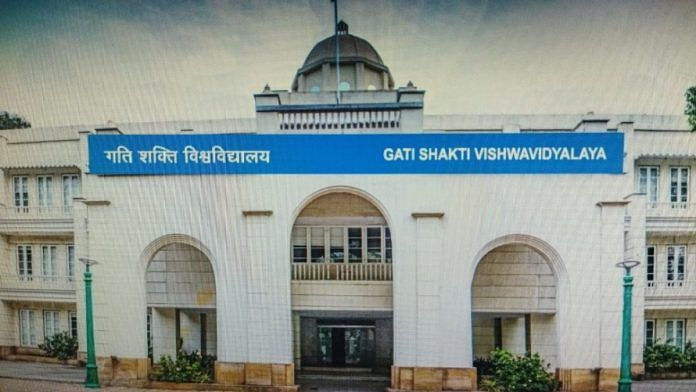New Delhi: Come August, some 922 students from across India will start their classes in Vadodara’s Gati Shakti Vishwavidyalaya (GSV) — the first such central university in India, to teach specific aspects of transport infrastructure and the logistics sector. The Gujarat-based university was set up to meet growing industry demand for specialised manpower in these areas.
Set up by the Railway Ministry in 2018 as the National Rail and Transportation Institute (NRTI), a deemed university, it got its central university tag in July last year and has been renamed the Gati Shakti Vishwavidyalaya. For its first batch this year, the new central university will offer two degrees, bachelor of engineering (B.Tech) and masters of business administration (MBA).
Applications for the batch starting in August were opened last month. While 202 students graduated from the NTRI this May, the current strength of the university across courses is 704. These 704 students will receive certification from Gati Shakti University, as will those taking admission from this year onwards.
“Against the backdrop of both the National Logistics Policy (2022) and the Gati Shakti masterplan (2021), there was a need for talented manpower in the transport and logistics sector, which, I believe, can be met by this educational institute,” Dr Manoj Choudhary, vice-chancellor (V-C), Gati Shakti Vishwavidyalaya, told ThePrint.
The National Logistics Policy is aimed at decreasing the cost of logistics by optimising efficiency, while the Gati Shakti masterplan looks at coordinated planning and implementation of infrastructure along connectivity projects.
Adding that the university was unique in its focus on imparting education on the transport sector, Chaudhary also said that railway engineering was just the starting point of courses for the university and it planned to accommodate teaching on other modes of transport in future — such as aviation and shipping.
While some students ThePrint spoke to complained of poor infrastructure and placements, Chaudhary said development was taking place in tandem with imparting education.
Also read: Just 2% of India’s rail track covered by Kavach, tech that ‘could have prevented Odisha tragedy’
Change from NRTI to GSV
The NRTI started operations on Teacher’s Day (5 September) 2018, admitting its first batch of 103 students from 20 states in two three-year full-time undergraduate courses — B.Sc in Transportation Technology and a Bachelor of Business Administration (BBA) programme in Transportation Management.
Media reports had at the time lauded the courses for being “highly multidisciplinary and experiential in nature”.
In 2020, two new B.Tech and MBA programmes, and four MSc courses were introduced.
The GSV is currently offering five B.Tech courses (four with specialisations in rail engineering and one in transports and logistics), and two MBA programmes on logistics and transport economies.
All M.Sc courses offered by the erstwhile NTRI have been scrapped. But students were admitted to the three-year BBA and B.Sc courses last year.
“Some courses, like the three-year programmes, had to be discontinued in order to align the university with the National Education Policy (NEP) that emphasises on four-year undergraduate degrees and others, because of (poor) demand in the market. B.Tech and MBA are the ones that remain because they are highly in demand,” Krishan Kumar, deputy registrar at the Gati Shakti University told ThePrint.
There have been other changes as well. According to the university website, it is collaborating with USA’s Cornell University, Russia’s St Petersburg State Transport University and the Japan Transport and Tourism Research Institute, among others, for short-term exchange programmes.
Admission to B.Tech courses is through JEE scores and a personal interview. For MBA, a bachelor’s degree (with math or statistics as one of the subjects), CUET-PG score, personal interview and work experience are the criteria. The NTRI held an entrance test for all its courses except B.Tech, admission to which was based on JEE scores.
Courses and Placements
According to Choudhary, the courses offered at Gati Shakti University teach the same fundamentals as any B.Tech or MBA course, but at the GSV, 15-20 per cent of the course module is made up of mandatory electives for specialised transport-specific knowledge and skills.
While there is no available data on placements, Choudhary said they were extending all possible help to get all their students from the current batch employed.
According to the information on the university website, past recruiters include Adani (ports and logistics), TATA consultancy services, logistics and supply chain company Delhivery, Railways public sector undertaking (PSU) Rail Vikas Nigam Limited (RVNL), and German industrial manufacturing company Siemens.
“Half of all executive council, which makes decisions for the university, comprises major industry players such as Rémi Maillard, president of Airbus India, and Pradeep Gaur, chairman and managing director of Rail Vikas Nigam, the construction arm of the railways ministry. They have been carefully chosen to bring guidance. Most of our faculty are IIT graduates. Then we have visiting professionals from the railways itself to create and share knowledge,” Choudhary said.
Some students ThePrint spoke to, however, complained about poor infrastructure.
”I did my entire course from home because it was pandemic time but when I visited the campus, I saw that the university building was not even ready… It looked like a temporary structure,” a student said on condition of anonymity.
Responding to their grievances, Choudhary said that the campus was spread over 55 acres and was in the process of getting another 110 acres for further development.
“The university cannot develop before the students come in, it has to be developed parallelly and they (the problems) were only at the beginning of the journey,” he said.
(Edited by Smriti Sinha)
Also read: 40 technicians, screw jacks & lot of devotion — how Railways ensures Puri Rath Yatra stays on course



